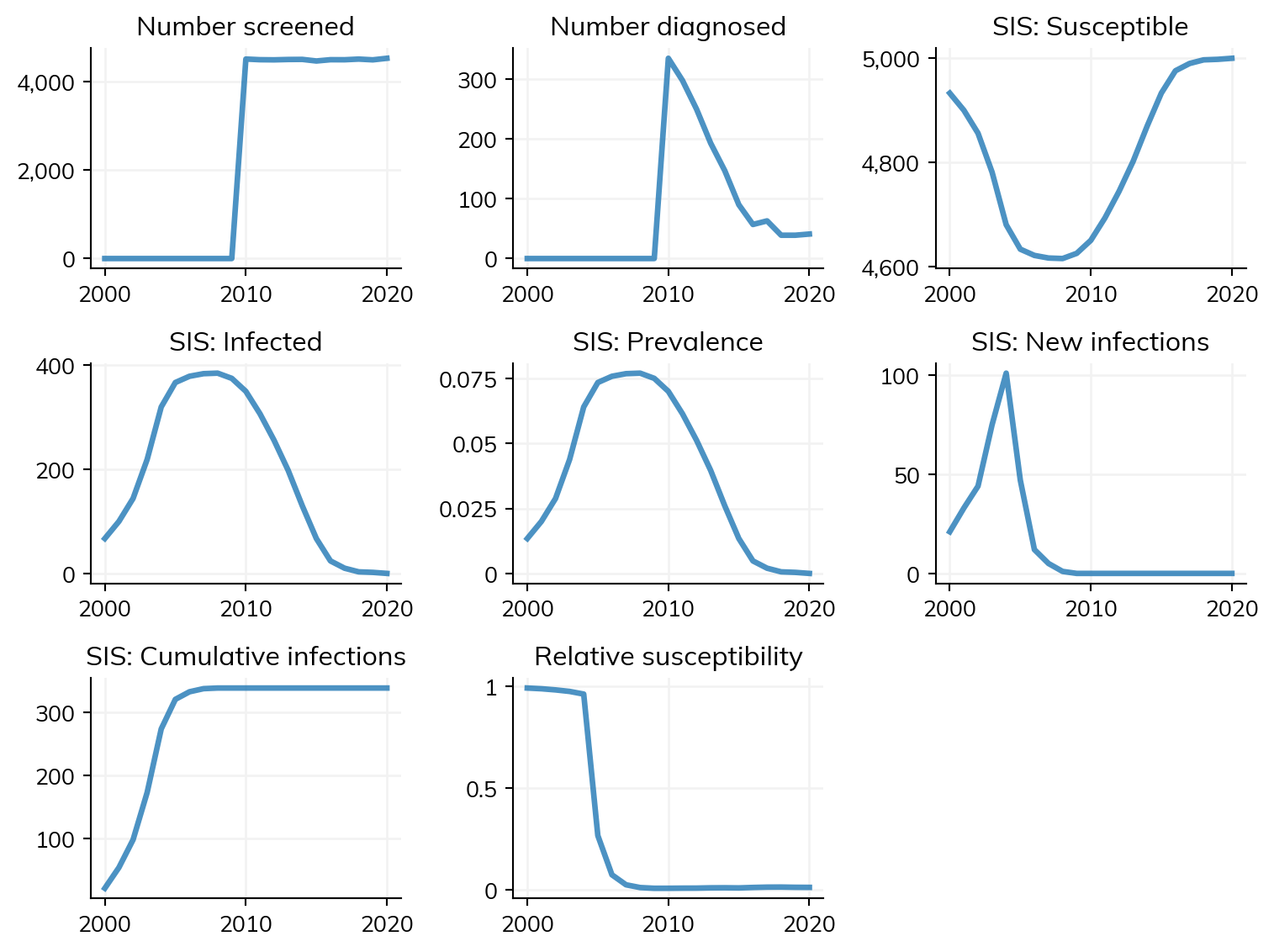import starsim as ss
# Lambda functions for simple eligibility
eligible_adults = lambda sim: (sim.people.age >= 18).uids
# More complex eligibility combining multiple conditions
def high_risk_eligibility(sim):
adults = sim.people.age >= 18
sexually_active = sim.networks.mfnet.participant
return (adults & sexually_active).uids
# Using intervention outcomes for triage
screen_positives = lambda sim: sim.interventions.screening.outcomes['positive']Interventions
This guide describes how to implementing interventions in Starsim. Interventions represent actions that affect disease transmission, such as screening, treatment, and vaccination programs.
For learning-oriented content on interventions, see Tutorial 6 - Interventions.
Comparison of intervention classes
Base classes
| Class | Purpose | Key features |
|---|---|---|
Intervention |
Base intervention class | Eligibility checking, product integration, step() method |
RoutineDelivery |
Continuous delivery over time | Interpolated probabilities, annual/timestep rates |
CampaignDelivery |
One-off or discrete campaigns | Specific years, optional interpolation |
BaseTest |
Base for screening/triage | Product administration, outcome tracking |
BaseScreening |
Screening programs | Population-level eligibility checking |
BaseTriage |
Triage/follow-up testing | Targeted eligibility (e.g., screen positives) |
BaseTreatment |
Treatment interventions | Queue management, eligibility validation |
BaseVaccination |
Vaccination programs | Dose tracking, vaccination state management |
Screening interventions
| Class | Delivery pattern | Use case |
|---|---|---|
routine_screening |
Continuous | Regular screening programs (e.g., annual STI screening) |
campaign_screening |
Discrete | Mass screening events (e.g., outbreak response) |
routine_triage |
Continuous | Follow-up testing for positives |
campaign_triage |
Discrete | Campaign-based confirmatory testing |
Treatment interventions
| Class | Capacity Model | Use Case |
|---|---|---|
treat_num |
Fixed capacity per timestep | Resource-constrained treatment programs |
Vaccination interventions
| Class | Delivery Pattern | Use Case |
|---|---|---|
routine_vx |
Continuous | Routine immunization programs |
campaign_vx |
Discrete | Mass vaccination campaigns |
Implementation patterns
Eligibility functions
Interventions use eligibility functions to determine who can receive the intervention:
Product integration
Interventions work with products that define the actual medical intervention:
import sciris as sc
import starsim as ss
# Define parameters
pars = sc.objdict(
n_agents = 5e3,
start = 2000,
stop = 2020,
diseases = 'sis',
networks = 'random',
)
# Define the product data
dx_data = sc.dataframe(
columns =
['disease', 'state', 'result', 'probability'],
data = [
['sis', 'susceptible', 'positive', 0.01],
['sis', 'susceptible', 'negative', 0.99],
['sis', 'infected', 'positive', 0.95],
['sis', 'infected', 'negative', 0.05],
]
)
# Using built-in products
vx_start = 2005
my_vaccine = ss.simple_vx(efficacy=0.9)
vaccination = ss.routine_vx(
product = my_vaccine, # Product object
prob = 0.8,
start_year = vx_start,
)
# Using custom products
dx_start = 2010
screening = ss.routine_screening(
product = ss.Dx(df=dx_data),
prob = 0.9,
start_year = dx_start,
)
# Run the sim
sim = ss.Sim(pars, interventions=[screening, vaccination])
sim.run()
sim.plot()Initializing sim with 5000 agents
Running 2000.01.01 ( 0/21) (0.00 s) ———————————————————— 5%
Running 2010.01.01 (10/21) (0.30 s) ••••••••••—————————— 52%
Running 2020.01.01 (20/21) (0.40 s) •••••••••••••••••••• 100%
Figure(768x576)
Adding multiple interventions
If you want to add multiple of the same intervention, you need to give them different names. (This also applies to diseases and other modules.) This example compares simulations with 0, 1, or 2 vaccines:
import starsim as ss
# Create the product - a vaccine with 80% efficacy
vx = ss.simple_vx(efficacy=0.8)
# Create the interventions -- low and high coverage
intv_low = ss.routine_vx(name='intv_low', start_year=2010, prob=0.2, product=vx)
intv_high = ss.routine_vx(name='intv_high', start_year=2020, prob=0.6, product=vx)
# Create the sims
pars = dict(n_agents=5000, networks='random', diseases='sis', verbose=0)
s0 = ss.Sim(pars, label='Baseline')
s1 = ss.Sim(pars, label='Low vaccine coverage', interventions=intv_low)
s2 = ss.Sim(pars, label='Low + high vaccine coverage', interventions=[intv_low, intv_high])
# Run & plot
msim = ss.parallel(s0, s1, s2)
msim.plot('sis_new_infections')Exception ignored in: <_io.BytesIO object at 0x7fdec33226b0>
Traceback (most recent call last):
File "/opt/hostedtoolcache/Python/3.13.7/x64/lib/python3.13/copyreg.py", line 99, in __newobj__
return cls.__new__(cls, *args)
BufferError: Existing exports of data: object cannot be re-sizedFigure(768x576)